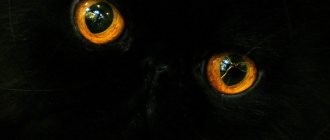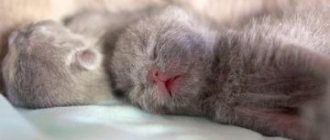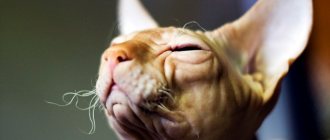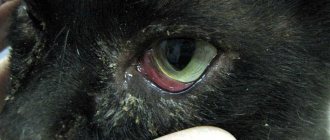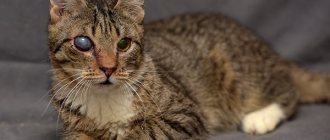The history of cat domestication goes back more than 4 thousand years, and according to one version - about 9 thousand! Despite such a long relationship, cats, largely due to their independent nature, remain mysterious creatures in the eyes of humans. Their actions cannot always be explained rationally, and their abilities have not been studied to this day. For example, what do we know about cat vision?
Color or black and white world
For quite a long time it was believed that the “mustachioed-striped” see the world around them in black and white. Studies were conducted that confirmed this fact.
However, scientists, as often happens to them, were wrong. It turned out that cats distinguish colors, although not all:
- see: gray, blue, green and their shades,
- do not see: red, brown and orange,
- They are also available in white, black and shades of gray.
But why is the whole spectrum of colors not available to them, why don’t cats see surrounding objects the same way as we do? It's all about the structure of the eye.
Why do newborn kittens have blue eyes and how eye color changes
To understand exactly how the change in eye color in kittens works, you need to start with the very development of the kitten in the womb. Already at the initial stages, 34 pigment centers are localized in the embryo, from which the pigment, during the growth and development of the kitten, moves mostly to the hair follicles and accumulates there. There is negligible amount of it in the iris.
The most interesting thing is that the pigment continues to accumulate after birth, which is why the color of the kittens’ eyes changes.
But why do all newborns have blue, gray-blue or blue eyes? It's all about the amount of pigment (melanin) - it is known that the less pigment, the lighter and cooler the eye shade. At the time of birth there is little of it in the iris. This is the reason why all babies have cool blue or light blue eyes.
There is no pigment in the eyes of newborn kittens, so they have blue eyes.
Actually, what final eye color a kitten will have is determined by a set of genes inherited from the parents to the baby. It is responsible for the amount and presence of pigment in the eyes and the speed of its movement there. This is what determines when the eye color changes and what it will be like.
The cat's iris is divided into two layers: the upper one is the stroma and the lower one is the epithelium. It is the amount of melanin in the stroma that is responsible for eye color. If there is a lot of it, then the color will be brown or copper, if less - green, if very little - blue or cyan.
With a probability of at least 50% you can predict what eye color a kitten will have if you look at its parents
The structure of the organs of vision
Everyone knows that a cat is one of the few warm-blooded creatures that have a vertical pupil that dilates in the dark.
But the general structure of the eyes of these animals is not too different from the structure of the human eye:
We also recommend reading:
Pet habits: what signals should you pay attention to? Top 7 Dogs That Are Great for Children Stubborn Personality: Dogs That Are Difficult to Train Ways to Correct Malocclusion in Puppies
- The eyes are located in the front (a feature of predators and humans), vision is binocular or stereoscopic vision, which allows you to see objects with both eyes at once, in volume and estimate the distance to them.
- The eyeball consists of three layers: the sclera, the vascular layer and the retina.
- Fluid fills the eyeball.
- The nerves are “connected” to the back of the eye and connect it to the brain.
However, there are also differences:
- The cornea, the top layer of the sclera, occupies a much larger area and is more convex than the human cornea. That is why a cat’s viewing angle is as much as 200 degrees (for a human it is 180).
- A cat's eye has a tapetum, the very back layer of the retina that reflects light. Therefore, the eyes of these creatures “glow” in the dark. In fact, they simply reflect external light.
- Cats also have more special “devices” of rods responsible for light sensitivity than humans and many other mammals. Thanks to this, cats see us much better in the dark.
- Felines lack the “blind spot” to which nerve endings are attached in humans. These pets have a special disc and special “flasks” in this place, which also improve light sensitivity.
From what was written above, it is easy to conclude that cats see much better than people. Is it really?
Caring for the eyes of a sick and healthy cat
To make the therapy as effective as possible, we recommend taking a few simple tips:
- The room where the sick animal is located requires daily wet cleaning. In addition, it is necessary to ensure dim, dim light and the absence of sharp, loud sounds;
- After adding the drops, it is better to hold the pet in your arms for a couple of minutes, holding its paws. Otherwise, it will try to remove the drug;
- It is worth trimming the claws as short as possible, otherwise if the cats are very itchy, they may injure their eyes. If you are not sure that you can shorten the claws without harm to your pet, contact the veterinary clinic;
- Dehydration should not be allowed. If the animal refuses water, you will have to feed it from a pipette or syringe without a needle. It would also be a good idea to check with the doctor what oral rehydration products can be given to the patient;
- If your patient has been prescribed antibiotics, do not forget to also ask for a prebiotic. This will prevent eating disorders and problems with microflora;
- During treatment, it is not recommended to bathe the animal or let it go outside. Your task is to provide your pet with your careful care, peace and comfort;
I deserve your attention, master, don't I?
There is often a recommendation online to wash the eyes of a healthy mursak every day with boiled water, a decoction of herbs or saline. However, experts do not advise listening to it: excessive disinfection weakens local immunity, which is why the risk of fungal, bacterial, viral infection or parasitic infection increases significantly.
If you are concerned about the health of your purr, and inaction is death for you, make an appointment with your veterinarian to discuss possible prevention options.
How well and how far do cats see?
Surprisingly, these beautiful predators are myopic! They see objects best at a distance of no more than 6 meters. The clarity of vision of cats extends to a distance of about 20 meters, then a blurred spot.
This seems strange, because they are predators and successful hunting and the survival of the species depend on vision.
However, cats, unlike ancient people and large predators, hunt small prey, usually hiding not far from the ground. They simply don't need to look too far ahead!
Eye color standards
Each breed has a personal accepted standard for eye color. These are quite strict rules that should not be broken.
So, which breeds have strict restrictions on eye color:
- Abyssinian cat. This breed can only have green or yellow eyes.
- Burmese cat. This beauty's eyes can only be light gold.
- Burmilla. Green of any intensity.
- Balinese. Blue or blue eyes.
- Bombay cat. Only deep copper eye color.
- Burmese cat. Exceptionally bright blue eye color.
- Havana brown. Green or yellowish-green.
- Egyptian Mau. The eyes are light green (gooseberry color).
- Korat. Amber or amber-green eyes.
- Kao-mani. Yellow or blue eyes.
- Lykoy. Yellow or amber eyes.
- Nibelung. Only gooseberry eye color.
- Oriental cat. Green eye color is preferred.
- Ojos azules. Only blue eyes.
- Pixie bob. The eyes are gooseberry-colored, brown or yellow.
- Russian blue cat. Exceptionally green eyes, from light to rich emerald.
- Ragdoll. Only blue eyes.
- Siamese cat. Blue or blue eyes.
- Tonkinese cat. Aquamarine, blue or yellow eye color.
- Thai cat. Only deep blue eye color.
- Turkish van. Only gold or blue.
- Chausie. Yellow, copper, hazel or green eye color.
- Chartreuse (Carthusian cat). Copper, orange or amber eyes only.
The standard of some cat breeds allows them to have only a certain eye color (pictured are Havana Brown cats)
In some breeds, eye color may depend on coat color:
- British cats of the black solid, blue solid, cinnamon, fawn, and lilac colors cannot be green-eyed or blue-eyed.
- British Chinchillas and British Goldens can only have green eyes.
- White Turkish Angoras can only be blue-eyed, green-eyed, or yellow-eyed.
- In Oriental cats, yellow and blue are allowed in solid (solid) colors and blue in color-point colors.
Some interesting facts about eye color in cats:
- A Sokoke cat can change eye color depending on its mood.
- Very often, blue-eyed cats (especially white ones) are deaf.
- All cat lovers know that the blue-eyed gene in purring cats is recessive. However, in cats of the Ojos Azules breed, this gene somehow mutated into a dominant one. They can also be green-eyed or yellow-eyed. Also, deafness is not associated with the Ojos blue-eyed gene and they cannot be bred with other blue-eyed cats.
- All color-point cats can only be blue-eyed or blue-eyed. Their eyes absorb all colors of the rainbow spectrum except blue. They reflect it and therefore appear blue-eyed. But the brightness of blue depends on the amount of pigment: the more pigment there is, the paler the color of the cat’s eyes. In very rare cases, Color Points may have yellow eyes.
- If a cat has no pigment in her eyes, she will be red-eyed. This only occurs with albinism.
- Albinos can also have blue eyes (this is called partial albinism).
- As surprising as it may sound, outbred cats usually have much richer eye color than many purebred cats.
Abyssinian cats most often have green eyes
How are things going with frame 25?
Almost everyone knows that the speed of human frame perception is 24 frames per second. This is precisely what the notorious 25th frame effect is based on, which a person no longer perceives, but, as it were, “records” into the subconscious.
If someone wanted to “zombify” cats, they would have to include not the 25th, but the 41st or even the 51st frame in the films, because this is precisely the speed of perception of our pets.
A fast-flying fly (in human understanding) does not move so fast for cats: a precise blow with its paw is enough to knock it down.
Symptoms of diseases
Knowing what healthy visual organs in cats should look like (we wrote about this above), calculating any deviations from the norm is not a problem. Typically, the onset of eye disease in domestic cats manifests itself in:
- hyperemia of the mucous membranes of the eyelid (swelling, redness occurs);
- itching (the animal often rubs its face with its paw);
- change in color, dimming of the iris, white, appearance of vascular networks or spots;
- mucous or purulent discharge, tearing, film formation;
- inflammatory, purulent formations on the eyelids, plaque or crusts along the eyelash edge;
- violation of the integrity of the skin membranes, scratches due to physical trauma;
- photophobia, expression of discomfort (the animal shakes its head, squints, cannot open its eyelids);
The “bouquet” of symptoms depends on what disease has affected the organs of vision of your patient. Remember: the same symptom can be characteristic of several diseases; only a doctor can make a diagnosis.

